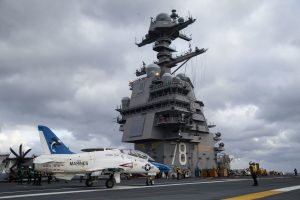Could the Gerald Ford (CVN-78) class be capped at four ships? That’s the upshot of a remarkable new study on the future of naval aviation. At Breaking Defense, Paul McCleary offers some detail on how the Navy is thinking about the its carrier force beyond the four ship buy of the Ford class. According to McCleary, the Acting Secretary of the Navy is forming a Future Carrier 2030 Task Force, which explore options for extending or reconceptualizing the carrier fleet beyond the acquisition of the final CVN-78 ship.
At stake is not only the enormous cost of a Ford; there are also enduring concerns about the vulnerability of the supercarrier as a platform. The lethality and relative invulnerability of land-based missile systems, combined with the complications created by a network of air, surface, and subsurface weapons platforms, has served to make contested waters a dangerous place even for the largest and most well-protected aircraft carrier. Tyler Rogoway recaps the key points, including the observation that a follow-on to the Ford class would be smaller and less expensive, and that doctrine for the employment of supercarriers may change from high intensity strike to sea control.
One of the options under study includes the Lightning Carrier concept, which involves developing management systems to enable the large, flat-decked amphib fleet to operate the F-35B at a relatively high sortie rate. Incidentally, this enhances the strategic relevance of the F-35B, the world’s only supersonic stealth fighter capable of taking off from STOVL aircraft carriers. The F-35B is already or will shortly become the primary fighter for the British, Japanese, and Italian, navies. Another option could involve supercarriers, just somewhat less super. The United States Navy could pursue more modestly sized carriers, perhaps somewhere between the Fords and the French Charles de Gaulle, that could range more widely at less exhaustive cost.
Capping the Ford by at four ships would have vast ripple effects in the defense industrial base. Currently, only one shipyard in the world can build and refurbish nuclear supercarriers, although that may change as China’s shipbuilding ramps up. The administrative and industrial know how bound up at Newport News cannot be easily replaced; if the United States decides to stop building supercarriers, it may not be able to start up again, at least with current manufacturing practice and technology. Planning for the development of a successor ship would need to take these industrial realities into account.
In any case, the future of the U.S. Navy stands at a crossroads. For seventy-five years, large carriers have dominated its doctrine, and served as the foundation for its dominance. Now, that dominance stands in question on both counts.

































